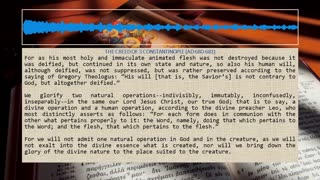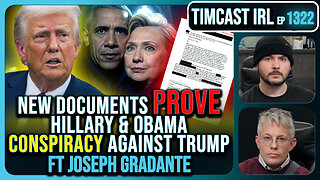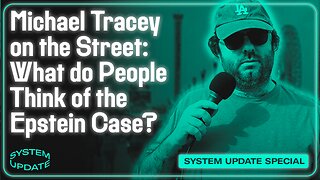Premium Only Content

Mike Winger Critique Episode 14: Understanding the Day of Atonement
Paul Vendredi rejoins Idol Killer to discuss the Day of Atonement. The show begins with the issue of the authorship of the Book of Hebrews and why it is problematic for Mike Winger to rely on it in his arguments. According to the hosts, the ancient Church determined that Hebrews was Pauline in authorship, but this is disputed by those in the atonement school, who argue that it does not meet the criterion of being written by an apostle or someone approved by an apostle. Paul questions why Winger relies so heavily on this book--which is non-canonical according to his own denomination’s criteria! Bizarrely, Winger also attacks the reliability of the Septuagint (LXX), the very translation on which the book of Hebrews depends. A medley of three video clips from Gary Rendsburg, an expert on the Dead Sea Scrolls, reveals the discovery of Greek translations of the Old Testament in jars near Jericho and the existence of a Proto-Septuagintal strain, facts that undermine Winger's critiques of the LXX.
As in previous videos, Winger pits himself against his peers in the atonement school. Despite the general position of the atonement school that the Old Testament sacrifices were useless salvifically, Mike Winger seems to argue that sacrifices offered on the Day of Atonement actually make atonement. However, he stays on the reservation by declaring the Day of Atonement a picture of Christ. Paul argues against its picturing Christ, seeing it rather as an accommodation to the Hebrews' pagan mindset. He explains that the sacrifice of the Passover lamb was insufficient in breaking the Hebrews from their pagan ways, and God allowed them to believe that their offerings were appeasing Him and giving Him food and drink, similar to the practices of the pagan nations around them. The Psalms, Proverbs, and Prophets gradually moved readers away from the primitive Pagan idea of viewing God as a deity who required sacrifices and animal offerings. Instead, God was seen as focusing on the restoration of the relationship between humans and Himself. Paul uses the analogy of teaching children math to explain how God gradually introduced new concepts to the ancient Israelites, even if it meant going against previous teachings for pedagogical reasons.
Much discussion of the Ark of the Covenant ensues. Contrary to the common belief that priests could only enter the Holy of Holies once a year, priests were actually allowed to present themselves before the Ark of the Covenant at other times. Phinehas and Moses were able to enter the Holy of Holies on days other than Yom Kippur without being struck dead.
Paul also contends that the Temple that stood from the time of Zerubbabel to Christ's time was illegitimate, as it had an empty Holy of Holies and an illegitimate altar due to historical events such as the defilement of the altar by Antiochus IV Epiphanes and the lack of a legitimate prophet to guide the priests. As a result, during the observance of the Day of Atonement, the goat was sacrificed on an illegitimate altar and its blood sprinkled into an empty Holy of Holies. The belief among Jews that Jeremiah would return with the Ark of the Covenant, bringing the pot of manna it contained to feed the Israelites indicates that they knew the Holy of Holies was empty.
Penal-substitutionary atonement is facing crisis and a new paradigm is needed, specifically the Restored-Icon Model held by Eastern Christians.
-
 4:30
4:30
Paul Vendredi
1 month ago3 Constantinople
9 -
 DVR
DVR
SpartakusLIVE
5 hours agoDuos w/ @GloryJean || #1 Masculine Muscle MASS sears YOUR retinas with MIND BENDING content
100K -
 3:05:49
3:05:49
TimcastIRL
4 hours agoNew DOCS PROVE Obama Hillary CONSPIRACY To SABOTAGE Trump Admin | Timcast IRL
186K57 -
 2:29:36
2:29:36
Laura Loomer
5 hours agoEP136: YOU'RE FIRED! White House Vetting Crisis Continues
18.2K11 -
 8:07
8:07
MattMorseTV
5 hours ago $0.32 earnedTrump just LOWERED PRICES by 75 PERCENT.
12.8K24 -
 LIVE
LIVE
Misfit Electronic Gaming
7 hours ago $0.13 earned"LIVE" "Blind Descent' +"Dollhouse of Dead" Playtest 10 Followers till we hit 1000! We CAN do this!
275 watching -
 21:53
21:53
Glenn Greenwald
7 hours agoMichael Tracey on the Street: What Do People Think of the Epstein Case?
113K54 -
 2:26:28
2:26:28
megimu32
4 hours agoOTS: Board Games Gone Wild! The Loud, Weird & Chaotic Games That Raised Us
13.5K6 -
 4:25:16
4:25:16
DamnDanieI
4 hours agoKill First, Loot Later – OTG Live
43.3K -
 56:41
56:41
Donald Trump Jr.
8 hours agoLies, Leaks, and Lawfare: Censorship Corruption Exposed | TRIGGERED Ep.263
154K121